Eysturoy
|
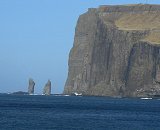
|
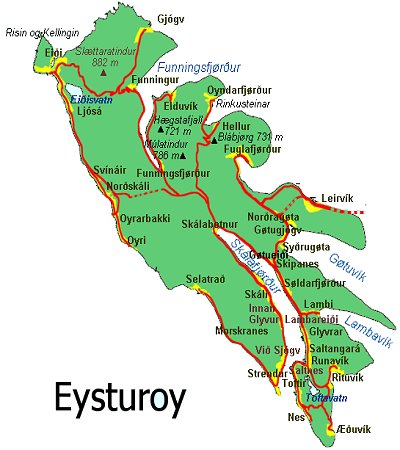 |
|
| Eysturoy
is the second largest island and lies about midway in the island group,
between the Northern islands and Streymoy. Eysturoy
is 268 km2 in area. The population on Eysturoy
is approx. 11,000 people. |
| Starting
from one end of the island there's the beautiful village Gjógv,
where the nature is amazing - you can go and see the bird cliffs where
puffins are (bring your binoculars). There's one hotel in the village,
called Gjáargardur. Drive about
20 mins from Gjogv there's Eidi - on the north-west end of Eysturoy. |
In Eidi Just beside Eidi there are two sea stacks just off the northern
coast of the island. called on faroese Risin and Kellingin (The
Giant and the Witch). The Giant (Risin) is the 71m stack further
from the coast, and the witch (Kellingin) is the 68m pointed stack
nearer land, standing with her legs apart. A legend tells how, once
upon a time, the giants in Iceland were envious and decided that
they wanted the Faroes. So the giant and the witch (his wife in
some versions of the story) were sent down to the Faroe Islands
to bring them back.They reached the north-westernmost mountain Eiðiskollur
(see map), and the giant stayed in the sea while the witch climbed
up the mountain with a heavy rope to tie the islands together so
that she could push them onto the giant's back. However, when she
attached the rope to the mountain and pulled, the northern part
of the mountain split. Further attempts were also unsuccessful,
and they struggled through the night, but the base of the mountain
was firm and they could not move it. They continued to struggle
and they didn't notice time passing, and as dawn broke a shaft of
sunlight put a stop to their efforts by turning them to stone on
the spot. They have stood there ever since, staring longingly across
the ocean towards Iceland. |
|
| The
stacks can be viewed by walking north from Eiði then turning east
towards the coast and following the low cliffs for a short way or
you can also get a good view of them if you drive to Tjørnuvík
onto the island Streymoy. |
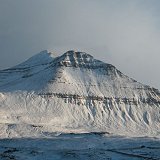 |
Between Eidi and Gjogv is
the largest mountain in the Faroe Islands, called Slættaratindur
and is 882 metres high. Its name means "flat summit".
It can be climbed in about four hours, and although the routes
are steep, technical climbing skills are not necessary to reach
the summit. In good weather the summit gives views over the entire
archipelago. Slættaratindur is one of ten mountains in the
Faroe Islands which rise to over 800m above sea level. Gráfelli,
the second-highest peak at 856 m, lies just to the north-east
of Slættaratindur.
Funningur is a nice place
to visit with your family when the weather is good. There's a
great river in the village where children have a great time playing
every summer.
Elduvík is located
in the Funningsfjørður-inlet on Eysturoy's northeast
side. The village is split into two parts by a small river. .
Visible from Elduvík is the nearby island of Kalsoy.
|
The
village Funningsfjørður is located at the end of a fjord
of the same name ('Fjørður' is the Faroese word for 'fjord').
The village was founded in 1812. There was a whaling-station in
Funningsfjørður from 1902 to 1913.
|
Oyndarfjørður
is a cosy little village on the northeastern coast of the Eysturoy.
The town's church dates from 1838. The village is famous for it's
two rocking stones ( rinkusteinar), located in the sea nearby. They
are rocking forth and back all the time. To visualize this a rope
is tied on to the rocks and ashore and people can go and hold the
rope and feel the movements.
|
|
Strendur is located on the
west side of Skálafjørður-inlet on Eysturoy.
The wool factory Snældan, which started in 1949, is at Strendur.
The factory started out as a spinning factory and then later began
to knit clothes. Árni Ziska who makes ornaments from Faroese
stone also lives in Strendur. He has made among other things the
memorial for fishermen lost at sea, which stands out on the point.
The Sjóvar church from 1834 is a beautiful wooden church
and the fifth oldest in the country.
|
| There
are many places for tourists to visit in Gøta. The famous
chieftain Tróndur í Gøtu lived in the old settlement
of Norðragøta where the ruins of his keep can be found.
The museum Blaðstova from 1933 was the largest farmhouse in
the village. Also an old fisherman’s house, Glyvra Hanusar
Hús has been preserved.
In the centre
of the residential area is the church in Gøtu (see picture
next to the map above), which is an old wooden church built in 1933.
In 1995 the new church was dedicated at Gøtugjógv.
The famous Tróndur Patursson made the altarpiece, lamps and
christening font, and other glassware. Blásastova
in Gøta welcomes you to see a complete, old, Faroese village
community with old farmers cottages, old fishermans cottages and
an ancient church. The museum provides a unique insight in the culture
and way of life in the Faroes in past centuries.
The wool factory
Tøting in Syðurgøta makes clothes from Faroese
wool.
|
|
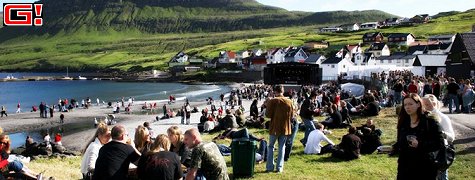 |
The
best festival in the Faroe Islands is held in Sydrugøtu and
it's the G! Festival.
It's
been rated in the top 25 of European Festivals outside of Denmark
for it's
beautiful environment in the village and the idyllic nature surrounding
the festival area.
Read more about
the festival on
their website |
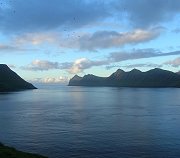
|
Leirvik is
located on the east coast of Eysturoy and is an ancient village
dating from the Viking Age. One of the best-preserved antiquities
in Faroes is located in Leirvík: Bønhústoft
which is a ruin of a prayer house with a churchyard and ancient
graves. One of two bowling halls in the Faroes is located in Leirvik,
next to the petrol station, Statoil. See the Bowling Hall's web
here. From Leirvik there's
an underwatertunnel (opened april 2006) to Klaksvik on the village
Bordoy. You need to pay toll to drive through the tunnel and the
toll can be paid at the Statoil or Shell tank stations on the
islands.
In the next town there's Fuglafjørður,
which is a relatively big village on Eysturoys east-coast . In
Fuglafjørður there's 'Mentanarhusid' (the Culture House),
where almost every weekend something is on such as live bands,
discoteque or theatre shows.
|
There
is a hot spring down by the sea south of the village. This is a
spring which, since the Middle Ages, people have believed has healing
qualities. The water's temperature is always around 18°C. Even
though the spring is insignificant in size, it is a popular tourist
attraction and it is still the centre of the festival "Varmakelda"
which is celebrated each year (first weekend in July) in Fuglafjørður |
| On
the south end of Eysturoy there's the town Runavik, which is the
3rd biggest town on the Faroes. There are over 10 kilometre long
residential area on the east bank Skálafjørður
(the fjord). Runavik is the main place for shopping for most of
the people on the island. The museum Forni in Glyvrar (Runavik)
is from the 17th century. Get the feeling of being transported back
in time, as you walk through the rooms, that are kept like they
were in the 18. hundreds. The museum also contains a shop from the
early 19. hundreds.
From Runavik there's a nice
drive around the lake - Toftavatn (from Runavik you drive to Saltnes
- Toftir - and then around back towards Rituvik). The bird life
in this area reaches its peak during the summer when it is visited
by the many migrating birds which return every year to the Faroes
to breed after having spent the winter in warmer climes. Bird watchers
ought to bring binoculars when visiting this area. The legend about
the water elf (Nykin) is connected to Toftavatn. The story tells
of the underwater being Nykin, that lived in Toftavatn. Sometimes
it rose up in the form of a handsome young man or a horse that lured
young women and children to it. Everyone who touched the Nykin,
was caught fast and was drawn down into the water with it. |
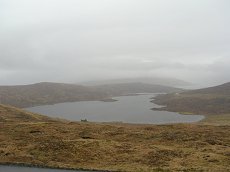 |
Æduvik
is the village furthest south on Eysturoy. There's a public toilet
in the village down by the sea.
MORE
INFORMATION LATER
|
|
 |
Hotel
Gjaargardur 

|
DKK
550+ |
| location:
Gjogv, Eysturoy |
|
| approx.
42 miles to Torshavn |
|
in beautiful little village- easily recognisable with nice grass-grown
roof. |
| |
|
|
|